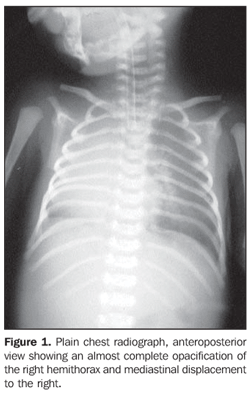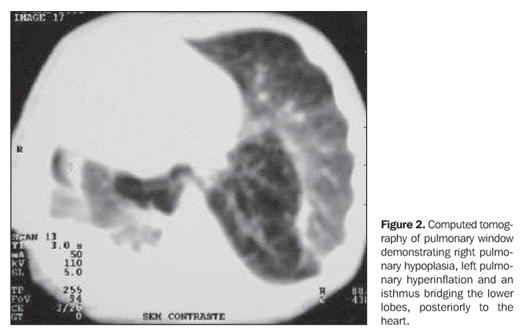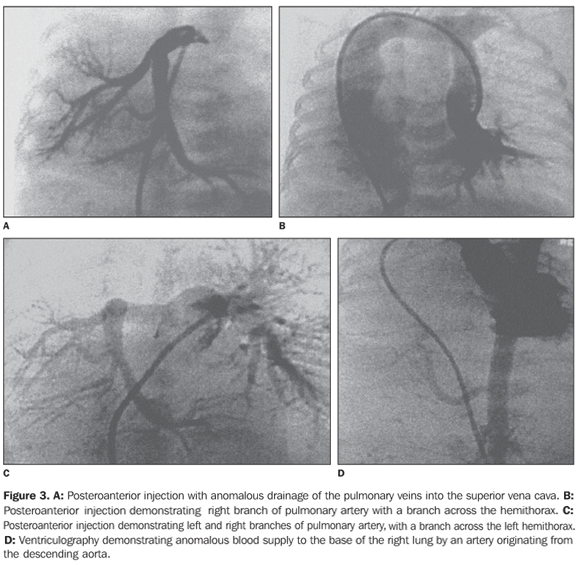Radiologia Brasileira - Publicação Científica Oficial do Colégio Brasileiro de Radiologia
AMB - Associação Médica Brasileira CNA - Comissão Nacional de Acreditação
 Vol. 40 nº 5 - Sep. / Oct. of 2007
Vol. 40 nº 5 - Sep. / Oct. of 2007
|
CASE REPORT
|
|
Horseshoe lung: a case report |
|
|
Autho(rs): João Paulo Kawaoka Matushita, Guilherme Carvalho Missiaggia, Roberto Márcio A. Peixoto, Hilton Muniz Leão Filho, Ricardo Saraiva Dias, Wilson Campos Tavares Junior, Cristina S. Matushita, José Nelson Mendes Vieira, João Paulo K. Matushita Junior |
|
|
Keywords: Horseshoe lung, Chest radiography, Computed tomography, Angiography |
|
|
Abstract:
INTRODUCTION Horseshoe lung was first described by Spencer in 1962(1), as a malformation in which an isthmus of pulmonary parenchyma extends from the right to the left lung bases across the midline posterior to the heart. The term "horseshoe lung" was coined in analogy to "horseshoe kidney"(2). Horseshoe lung can be defined as hypoplastic right lung and fusion of the posteroinferior segments of both lungs posteriorly to the heart and anteriorly to the esophagus and spinal column. The resulting isthmus of pulmonary parenchyma receives the blood supply from the right pulmonary artery, and the respective bronchi, from the right bronchial tree. So, the vessels and bronchus of the isthmus cross the midline, and this particular feature is found both in the angiography and bronchography. In cases associated with scimitar syndrome, the right hypoplastic lung presents with bronchial and vascular anomalies described in this syndrome. The pulmonary parenchyma is histologically normal(3). The isthmus presents its own pleural layer that is frequently incomplete, allowing communication between the right and left pleurae(3).
CASE REPORT A male newborn term infant who presented at birth with respiratory distress and persistent cyanosis. A chest radiographic image showed hypotransparency of the whole right hemithorax and hyperinflation of the left lung. A chest computed tomography was performed demonstrating a hypoplastic right lung and hyperinflation of the left lung with signs of air trapping in the lower lobe, with an image of continuity between the lower lobes, suggesting pulmonary herniation or horseshoe lung. The echodopplercardiogram showed dextrocardia and signs of pulmonary hypertension with severe dilatation of right chambers and a suspicion of anomalous pulmonary venous drainage. The hemodynamic study demonstrated pulmonary artery hypertension with total anomalous pulmonary venous drainage into the superior vena cava, a branch of the right pulmonary artery supplying the left lower pulmonary lobe, and na anomalous branch of descending aorta supplying the right lower pulmonary lobe.
Because of the pulmonary artery hypertension, the patient was submitted to surgical intervention for correction of the total anomalous pulmonary venous drainage. The child died, and the initial diagnosis was confirmed by means of necropsy.
DISCUSSION On conventional chest radiography, pathognomonic signs of horseshoe lung deformity cannot be observed(4,5). In patients with right pulmonary hypoplasia, associated or not with scimitar syndrome, the frontal view on a chest radiograph demonstrates dextrocardia, a variable degree of right hemithorax hypoplasia and a hyperinflated left lung. These findings are typical of horseshoe lung in association or not with scimitar syndrome, and with posterior fusion of the basal segments of the right and left lungs(6-8).
In the setting of this anomaly, the right lung is abnormal in terms of size, lobe and bronchial tree(9,10). The right pulmonary artery is usually abnormally hypoplastic, and, in some cases, is totally absent; on the other hand, in 40% of cases, its size is almost normal(11). Scimitar syndrome is characterized by a partially anomalous right pulmonary venous drainage into the systemic vein, usually bellow the diaphragm. This vein presents an oblique caudal course, resembling the short, curved sword called scimitar, and in 15% of cases is associated with horseshoe lung(12,13). In the present study, horseshoe lung was not observed in association with scimitar syndrome, but with total anomalous pulmonary venous drainage into the superior vena cava, with severe pulmonary hypertension. Association with other cardiovascular abnormalities, such as atrial septal defect, interventricular septal defect, persistent arteriosus ductus, single left ventricle, etc., may occur. In the suspicion of horseshoe lung, pulmonary arteriography should be performed. This method can detect variable degrees of right pulmonary artery hypoplasia and abnormal distribution of its segmental branches. Chest computed tomography is the best noninvasive method to confirm this diagnosis, demonstrating the pulmonary isthmus between the posterior region of the pericardium and the thoracic column. The angiographic study of the pulmonary artery is useful for diagnostic confirmation since this method allows the visualization of the right pulmonary artery with variable degrees of hypoplasia as well as a decrease in this artery segmentation. Also the level of the pulmonary artery pressure can be detected. The prognosis in cases of horseshoe lung is dependent on the pulmonary artery pressure. Usually, the types of horseshoe lung associated with normal pulmonary artery pressure are asymptomatic(2). Angiocardiography and echodopplercardiogram are utilized for evaluating associated cardiovascular abnormalities. Pathognomonic features related to horseshoe lung cannot be found on conventional chest radiographic images. The diagnosis may be reached by means of pulmonary arteriography and/or computed tomography. Currently, depending on the local diagnostic resources, an excellent assessment of the pulmonary vascularization can be performed by computed tomography and magnetic resonance imaging (angiotomography and angioresonance) or even helical and multiplanar computed tomography reconstruction techniques.
REFERENCES 1. Spencer H. Pathology of the lung. 3rd ed. Oxford: Pergamon Press, 1977;75–76. [ ] 2. Dupuis C, Remy J, Remy-Jardin M, Coulomb SM, Breviere GM, Ben Laden S. The "horseshoe" lung: six new cases. Pediatr Pulmonol 1994;17: 124–130. [ ] 3. Haworth SG, Sauer U, Buhlmeyer K. Pulmonary hypertension in scimitar syndrome in infancy. Br Heart J 1983;50:182–189. [ ] 4. Dische MR, Teixeira ML, Wincherster PH, Engle MA. Horseshoe lung associated with a variant of the "scimitar" syndrome. Br Heart J 1974;36: 617–620. [ ] 5. Thilenius OG, Ruschhaupt DG, Replogle RL, Bharati S, Herman T, Arcilla RA. Spectrum of pulmonary sequestration: association with anomalous pulmonary venous drainage in infants. Pediatr Cardiol 1983;4:97–103. [ ] 6. Felson B. Chest roentgenology. Philadelphia, PA: Saunders, 1973;87–92. [ ] 7. Felson B. Pulmonary agenesis and related anomalies. Semin Roentgenol 1972;7:17–30. [ ] 8. Richter K, Boch G. Dieanomalie der epibronchielen rechten. Pulmonaiarterieais. Litsymptom eines pulmo-kardiovakuioren syndromes. Rofo 1967;107:31–38. [ ] 9. Kittle CF, Crockett JE. Vena cava bronchovascular syndrome: a triad of anomalies involving the right lung: anomalous pulmonary vein, abnormal bronchi and systemic pulmonary arteries. Ann Surg 1962;156:222–233. [ ] 10. Neill CA, Ferencz C, Sabiston DC, Sheldon H. The familial occurrence of hypoplastic right lung with systemic arterial supply and venous drainage "scimitar syndrome". Bull Johns Hopkins Hosp 1960;107:1–21. [ ] 11. Farnsworth AE, Ankeney JL. The spectrum of the scimitar syndrome. J Thorac Cardiovasc Surg 1974;68:37–42. [ ] 12. Frank JL, Poole CA, Rosas G. Horseshoe lung: clinical, pathologic, and radiologic features and a new plain film finding. AJR Am J Roentgenol 1986;146:217–226. [ ] 13. Freedom RM, Burrows PE, Moes CA. "Horseshoe" lung: report of five new cases. AJR Am J Roentegenol 1986;146:211–215. [ ]
Received April 23, 2005. Accepted after revision January 8, 2007.
* Study developed in the Service of Radiology and Diagnostic Imaging - Hospital das Clínicas da Faculdade de Medicina da Universidade Federal de Minas Gerais (UFMG), Belo Horizonte, MG, Brazil. |
|
Av. Paulista, 37 - 7° andar - Conj. 71 - CEP 01311-902 - São Paulo - SP - Brazil - Phone: (11) 3372-4544 - Fax: (11) 3372-4554



